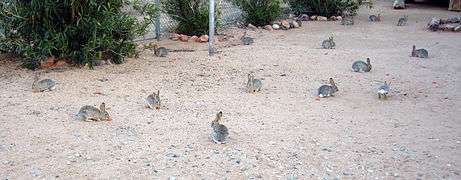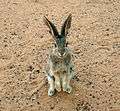Cottontail rabbit
| Cottontail rabbits[1] | |
|---|---|
 | |
| Eastern cottontail rabbit (Sylvilagus floridanus) eats grass, ferns, and leaves | |
| Scientific classification | |
| Kingdom: | Animalia |
| Phylum: | Chordata |
| Class: | Mammalia |
| Infraclass: | Eutheria |
| Order: | Lagomorpha |
| Family: | Leporidae |
| Genus: | Sylvilagus Gray, 1867 |
| Type species | |
| Lepus sylvaticus Bachman, 1837 (=Lepus sylvaticus floridanus J. Allen, 1890) | |
| Species | |
|
16 sp., see text | |
Cottontail rabbits are among the 17 lagomorph species in the genus Sylvilagus, found in the Americas.[1]
In appearance, most cottontail rabbits closely resemble the wild European rabbit (Oryctolagus cuniculus). Most Sylvilagus species have stub tails with white undersides that show when they retreat, giving them their name: "cottontails". This feature is not present in some cottontails (for example, the underside of the brush rabbit's tail is gray), nor is it unique to the genus (for example, the European rabbit also has a white scut).
The genus is widely distributed across North America, Central America, and northern and central South America, though most species are confined to particular regions. Most (though not all) species live in nests called forms, and all have altricial young.
Cottontail rabbits show a greater resistance to myxomatosis than European rabbits.[2]
Lifespan
The lifespan of a cottontail averages about two years, depending on the location. Almost every living carnivorous creature larger or faster than the lagomorph is its predator. That includes: domestic dogs, humans, snakes, coyotes, mountain lions, and if the cottontail is showing signs of illness, even squirrels.
The cottontails biggest threat comes from above. Large birds of prey swoop down on cottontails, and sometimes carry them upwards, and then drop them to end their life, or stun them with an aerial assault, and poke them to death. Those cottontails particularly vulnerable to attack, are the newborn. Cottontail lagomorphs borrow burrows that have been vacated by other animals. Some predators, like snakes for example, are well aware of the local real estate used and reused by the cottontails, and make a meal of the young at will, with little or no resistance by the mother rabbit. She is defenseless against any and all that would get close enough to eat her or her young. Though cottontails are very sexually active creatures, and mated pairs have several offspring many times in all seasons, it is more likely than not that none will survive to adulthood. Those that do manage to avoid being eaten, grow very quickly and are considered full grown adults at three months. [3]
Eating mechanics
Unlike the squirrel and chipmunk that eat sitting up on their hind legs and can hold food with their front paws while spinning it in circles to devour it quickly, the desert cottontail, like all cottontails, eats on all fours. It can only use its nose to move and adjust the position of the food that it places directly in front of its front paws on the ground. The cottontail rabbit will turn the food with its nose to find the cleanest part of the vegetation (free of sand and inedible parts) to begin its meal. The only time a cottontail uses its front paws to enable eating is when vegetation is above its head on a living plant. The cottontail will lift its paw to bend the branch to bring the food within reach.[4]
Cottontails are rarely found out of their burrows looking for food on windy days, because the wind interferes with their hearing capabilities. Hearing an oncoming predator is their primary defense mechanism.[5]
-

California eight-week-old desert cottontail eating a carrot
-

Cottontails are very sociable animals within their peer group
-

A Juvenile desert cottontail displays a wounded ear it received from an adult cottontail over a food dispute a week earlier
Species

Genus Sylvilagus
- Subgenus Microlagus
- Sylvilagus bachmani – Brush rabbit
- Subgenus Sylvilagus
- Sylvilagus audubonii – Desert cottontail
- Sylvilagus cognatus – Manzano mountain cottontail
- Sylvilagus cunicularius – Mexican cottontail
- Sylvilagus floridanus – Eastern cottontail
- Sylvilagus graysoni – Tres Marias rabbit
- Sylvilagus nuttallii – Mountain cottontail
- Sylvilagus obscurus – Appalachian cottontail or rarely Allegheny cottontail
- Sylvilagus robustus – Robust cottontail
- Sylvilagus transitionalis – New England cottontail
- Subgenus Tapeti
- Sylvilagus aquaticus – Swamp rabbit
- Sylvilagus brasiliensis – Tapeti
- Sylvilagus dicei – Dice's cottontail
- Sylvilagus insonus – Omilteme cottontail
- Sylvilagus palustris – Marsh rabbit
- Sylvilagus varynaensis – Venezuelan lowland rabbit
- Subgenus unknown
- Sylvilagus mansuetus – San Jose brush rabbit
Gallery
-

Desert cottontail (Sylvilagus audubonii) in submissive posture anticipating food
-

From behind with white tail easily visible
-

On alert
-

California high desert cottontail resting on a full stomach
-

Mother and juvenile cottontail enjoying a carrot dinner
-

A desert cottontail at 26 months of age
References
- 1 2 Hoffman, R.S.; Smith, A.T. (2005). "Genus Sylvilagus". In Wilson, D.E.; Reeder, D.M. Mammal Species of the World: A Taxonomic and Geographic Reference (3rd ed.). Johns Hopkins University Press. pp. 207–211. ISBN 978-0-8018-8221-0. OCLC 62265494.
- ↑ Carter, G.R.; Wise, D.J. (2006). "Poxviridae". A Concise Review of Veterinary Virology. Retrieved 2006-06-13.
- ↑ "Sylvilagus floridanus".
- ↑ "Small mammals" (PDF).
- ↑ "Rabbits and Hares".